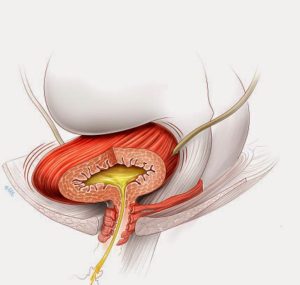ِ Neurogenic bladder dysfunction, or neurogenic bladder, refers to urinary bladder problems due to disease or injury of the central nervous system or peripheral nerves involved in the control of urination. There are multiple types of neurogenic bladder depending on the underlying cause and the symptoms. Symptoms include overactive bladder, urinary urgency, frequency, incontinence or difficulty passing urine. A range of diseases or conditions can cause neurogenic bladder including spinal cord injury, multiple sclerosis, stroke, brain injury, spina bifida, peripheral nerve damage, Parkinson’s disease, or other neurodegenerative diseases. Neurogenic bladder can be diagnosed through a history and physical as well as imaging and more specialized testing. Treatment depends on underlying disease as well as symptoms and can be managed with behavioral changes, medications, surgeries, or other procedures. The symptoms of neurogenic bladder, especially incontinence, can have a significant impact on quality of life.
Neurogenic bladder dysfunction, or neurogenic bladder, refers to urinary bladder problems due to disease or injury of the central nervous system or peripheral nerves involved in the control of urination. There are multiple types of neurogenic bladder depending on the underlying cause and the symptoms. Symptoms include overactive bladder, urinary urgency, frequency, incontinence or difficulty passing urine. A range of diseases or conditions can cause neurogenic bladder including spinal cord injury, multiple sclerosis, stroke, brain injury, spina bifida, peripheral nerve damage, Parkinson’s disease, or other neurodegenerative diseases. Neurogenic bladder can be diagnosed through a history and physical as well as imaging and more specialized testing. Treatment depends on underlying disease as well as symptoms and can be managed with behavioral changes, medications, surgeries, or other procedures. The symptoms of neurogenic bladder, especially incontinence, can have a significant impact on quality of life.
Classification
There are different types of neurogenic bladder depending on the underlying cause. Many of these types may have similar symptoms.
Uninhibited
Uninhibited bladder is usually due to damage to the brain from a stroke or brain tumor. This can cause reduced sensation of bladder fullness, low capacity bladder and urinary incontinence. Unlike other forms of neurogenic bladder, it does not lead to high bladder pressures that can cause kidney damage.
Spastic
In spastic neurogenic bladder (also known as upper motor neuron or hyper-reflexive bladder), the muscle of the bladder (detrusor) and urethral sphincter do not work together and are usually tightly contracted at the same time. This phenomenon is also called detrusor external sphincter dyssynergia (DESD). This leads to urinary retention with high pressures in the bladder that can damage the kidneys. The bladder volume is usually smaller than normal due to increased muscle tone in the bladder. Spastic neurogenic bladder is usually caused by damage to the spinal cord above the level of the 10th thoracic vertebrae (T10).
Flaccid
In flaccid bladder (also known as lower motor neuron or hypotonic bladder), the muscles of the bladder lose ability to contract normally. This can cause the inability to void urine even if the bladder is full and cause a large bladder capacity. The internal urinary sphincter can contract normally, however urinary incontinence is common. This type of neurogenic bladder is caused by damage to the peripheral nerves that travel from the spinal cord to the bladder.
Mixed
Mixed type of neurogenic bladder can cause a combination of the above presentations. In mixed type A, the bladder muscle is flaccid but the sphincter is overactive. This creates a large, low pressure bladder and inability to void, but does not carry as much risk for kidney damage as a spastic bladder. Mixed type B is characterized by a flaccid external sphincter and a spastic bladder causing problems with incontinence.
Signs and symptoms
Neurogenic bladder can cause a range of urinary symptoms including urinary urgency, urinary incontinence or difficulty urinating (urinary retention.) The first sign of bladder dysfunction may be recurrent urinary tract infections (UTIs).
